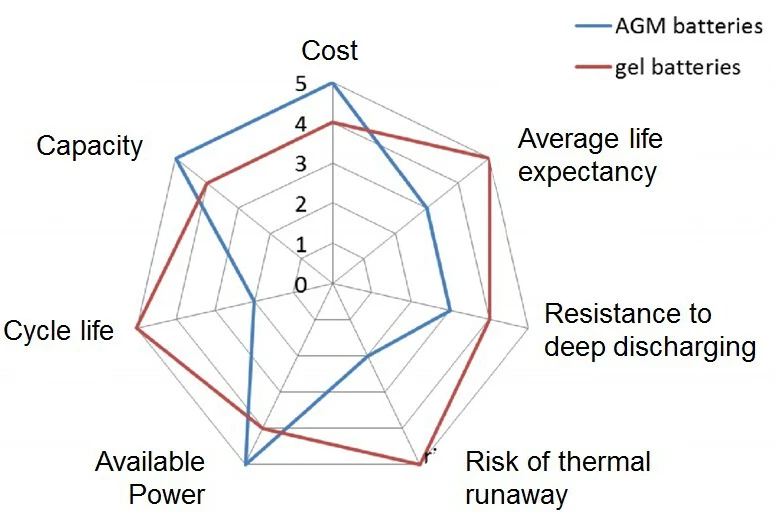AGM technology gained popularity in the early 1980s as a sealed lead-acid battery for military aircraft, vehicles, and UPS systems, aiming to reduce weight and enhance reliability. The sulfuric acid is absorbed by very fine glass fiber mats, making the battery spill-proof. This eliminates hazardous material transportation restrictions. The plates can be made flat, similar to standard flooded lead-acid packs in rectangular casings, or they can be wound into cylindrical cells.
1. What is an Absorbent Glass Mat (AGM) Battery?
Absorbent Glass Mat (AGM) batteries are a type of Valve-Regulated Lead-Acid (VRLA) battery, distinguished by their use of fiberglass mats to absorb the electrolyte, keeping the battery in a "dry state." This design not only enhances battery performance but also improves safety and durability.
Working Principle:
AGM batteries use fiberglass separators to absorb and retain the electrolyte, creating a stable electrochemical environment. They feature a sealed design where oxygen and hydrogen recombine internally, preventing electrolyte loss.
Structural Features:
The positive and negative plates are tightly wrapped in fiberglass separators, fully absorbing the electrolyte, leaving no free liquid inside the battery.

2. Core Advantages of AGM Batteries
Thanks to their unique design and performance, AGM batteries offer several advantages over traditional lead-acid batteries:
2.1 High Energy Density
AGM batteries have a higher energy density than conventional lead-acid batteries, storing more energy within a smaller volume, making them ideal for space-constrained applications.
2.2 Maintenance-Free Design
With a sealed structure, AGM batteries do not require regular electrolyte refilling, reducing maintenance costs and effort.
2.3 Excellent Charge and Discharge Performance
- AGM batteries support high-rate discharge, making them ideal for applications requiring instant high-current output (e.g., vehicle starting).
- High charging efficiency, enabling fast recharging.
2.4 Safety and Reliability
- The sealed design prevents electrolyte leaks, allowing stable operation even in tilted or vibrational conditions.
- The internal gas recombination mechanism reduces the risk of explosion, making AGM batteries suitable for high-safety applications.
2.5 Long Cycle Life
AGM batteries typically offer 2-3 times the cycle life of traditional lead-acid batteries, lowering long-term ownership costs.
3. Main Applications of AGM Batteries
Due to their high performance and reliability, AGM batteries are widely used in various industries:
3.1 Automotive Industry
- Starter Batteries: AGM batteries' high-rate discharge capability makes them ideal for vehicle starter batteries, especially in start-stop systems.
- Hybrid Vehicles: AGM batteries offer fast charging and discharging, making them suitable for auxiliary power systems in hybrid vehicles.
3.2 Renewable Energy
- Solar Energy Storage: AGM batteries' deep-cycle capability makes them perfect for solar energy storage, providing stable power during nighttime or cloudy conditions.
- Wind Energy Storage: Their high reliability and long lifespan make AGM batteries a preferred choice for wind energy storage systems.
3.3 Industrial & Backup Power
- UPS Systems: AGM batteries are widely used in Uninterruptible Power Supply (UPS) systems for data centers, hospitals, and critical facilities.
- Telecommunication Towers: The maintenance-free design and long service life of AGM batteries make them ideal for remote telecom towers.
3.4 Consumer Electronics
- Power Tools: AGM batteries' high energy density and fast charging capabilities make them a great power source for electric tools.
- RVs and Marine Applications: Their vibration resistance and safety features make AGM batteries suitable for recreational vehicles (RVs), boats, and yachts.
4. Comparison: AGM vs. Conventional Lead-Acid Batteries
| Feature | AGM Battery | Conventional Lead-Acid Battery |
|---|---|---|
| Energy Density | High | Low |
| Maintenance | Maintenance-free | Requires electrolyte refilling |
| Charge/Discharge | High-rate discharge, fast charging | Moderate discharge, slow charging |
| Safety | High (sealed design, no leakage) | Lower (risk of leakage) |
| Cycle Life | Long (500-1000 cycles) | Short (200-300 cycles) |
| Cost | Higher | Lower |
5. Future Trends in AGM Battery Technology
- Competition with Lithium Batteries: With advancements in lithium battery technology, AGM batteries face challenges in energy density and cycle life. However, their cost advantages and high safety allow them to remain competitive in specific markets.
- Technology Innovations: Future AGM batteries may see improvements in materials (e.g., carbon additives) and design (e.g., plate structure) to enhance performance.
- Eco-Friendly Recycling: AGM batteries' lead-acid materials can be efficiently recycled, aligning with circular economy trends.
6. Frequently Asked Questions (FAQ)
Q1: Can AGM batteries replace conventional lead-acid batteries?
Yes, but cost and application should be considered. AGM batteries offer superior performance but come at a higher price.
Q2: Do AGM batteries require a special charger?
Yes, AGM batteries require a compatible charger to ensure optimal charging efficiency and lifespan.
Q3: Are AGM batteries suitable for high-temperature environments?
AGM batteries may experience reduced performance in high temperatures. Proper ventilation is recommended for optimal operation.
Q4: How long do AGM batteries last?
Under normal usage, AGM batteries typically last 5-7 years.
Q5: Can AGM batteries be used for solar energy storage?
Yes, AGM batteries’ deep-cycle capability makes them highly suitable for solar power storage applications.
Conclusion
Absorbent Glass Mat (AGM) batteries, with their high energy density, maintenance-free design, excellent charge/discharge performance, and superior safety, are widely used in automotive, renewable energy, and industrial backup power systems. While they face increasing competition from lithium batteries, AGM batteries retain a strong market presence due to their unique advantages.
If you are looking for a high-performance, reliable battery solution, AGM batteries are a compelling choice worth considering.The manufacturer recommends stopping charging if the battery core temperature reaches 49°C (120°F).

